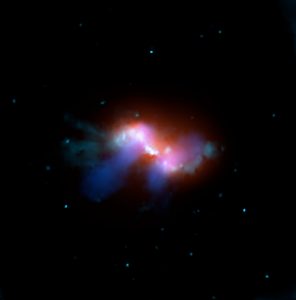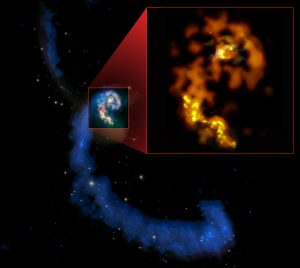The Very Large Array sees fountains of hot gas erupting from a beastly black hole in the heart of a large galaxy known to radio astronomers as Hercules A. For millions of trillions of miles, these jets shoot through space, finally slowing when they reach ancient gaseous hiccups left behind by this galaxy’s earliest days of star-forming fury.


The Black Hole in Radio Galaxy 3C 305
This bizarre galaxy has a supermassive black hole in its center. Data from three different wavelengths were used to create this composite image of galaxy 3C 305 in the constellation of Draco. The radio light, in blue, looks like headlights coming out of the galaxy and is caused by the magnetic field of the giant black hole.

ALMA First Image
In this composite image of the merging cores of the Antennae Galaxies, optical (white and pink), radio (blue) and millimeter/submillimeter (orange and gold) images are combined to show the history and future of star formation. The optical image represents stars that are shining now. The radio image highlights gas that is probably too thin to become a star, and at the mm/submm wavelengths we can see the areas where new stars will likely form.

Antennae Galaxies
Hard to believe that this was once a pair of spiral galaxies. Undergoing a violent merger, the well-named Antennae Galaxies are quite a spectacle to radio telescopes. In blue are the data from the VLA, showing the trails of hydrogen stripped from the outer arms of the two spirals. In orange and gold (inset) are the data from ALMA showing the areas of star formation caused by the collision of gas and dust clouds.

VLA Reveals Large Hydrogen Disk in UGC 5288
Dwarf galaxy UGC 5288 is 16 million light-years from Earth (seen here in pink). The Very Large Array (VLA) found that it is surrounded by a huge disk of hydrogen gas (purple) that has not been involved in the galaxy’s star-formation processes and may be primordial material left over from the galaxy’s formation.

Old, New, and Future Stars in NGC 3596
This gorgeous face-on spiral galaxy is called NGC 3596. This image combines Hydrogen-alpha emission (red), visible light in the R-band (white), and neutral hydrogen 21cm gas emission (blue) from the Very Large Array (VLA). What you see when you combine the invisible waves with visible ones is the enormous shroud of gas surrounding this galaxy. Mature stars twinkle in white, new stars shine their nursery clouds in reds, and the gas for future stars glows in blue.





